SEO
9 Examples of Highly Shareable Content

Social media is a powerful tool for marketers.
Unlike most forms of customer outreach and branding, it creates an opportunity to initiate and maintain a conversation with your targets.
This, in turn, lets you speak directly to them, address their needs, and explain why you offer the best solution.
But to get this started, you have to have the type of content that will first get their attention and then encourage interactions.
And for maximum exposure, you want something they’ll share.
This brand evangelizing lets you break out from your own circle of contacts and followers and tap into new groups to which you otherwise wouldn’t have been exposed.
So, how do you create shareable content that others will want to repost?
That’s exactly what we’re going to look at in this guide. We’ll examine different types of shareable content, what makes content shareable, and give you examples of formats you can employ.
Ready to get started? Let’s go.
Creating Shareable Content
If you’re Beyoncé, you can probably skip this section.
For anyone else, who doesn’t have tens of thousands of adoring fans who will repost anything you share, let’s take a look at some of the common features you’ll find in highly-shared content:
- It’s useful – People share content they find helpful with their friends and family, so they can also get help.
- It’s entertaining or amusing – Everyone loves to laugh. If you can make your target audience laugh, they’ll pass on that tickling item to others.
- It tells a compelling story – Since the first cavepeople gathered around a fire, humans have always loved discovering and sharing stories.
- It takes a clear stance about your values – No one will retweet something that says, “Both sides raise valid points.” Don’t be afraid to take a stand if it aligns with your values. Others who agree will share it.
- It has a visual component – While it can go viral with a text-only post, it’s a lot harder than something with a visual component.
- It’s timely – Latching on to trending cultural topics will generate a lot more exposure than a stale and outdated reference or meme. This includes “Keep Calm & (literally anything)”, jokes about Harambe, and any references to “all the feels.”
- It’s original – If you’re just recycling content that’s readily available, it will be largely ignored. Look for unique angles and make something new.
Now that we’ve discussed what makes content shareable, let’s dive into different types of content you can use to generate shares.
Types Of Sharable Content
1. Infographics
32.5% of marketers say they use infographics more than any other type of visual in their visual content marketing efforts.
Why? Because they provide information in an easily understood and digestible format.

A versatile medium that can be employed for many different purposes, infographics are visual storytelling tools. Some of their more common uses include:
- Timelines – Used to show planned steps, tell the history of an organization, or discuss future projections.
- Statistical – Numbers make a powerful point. Creating infographics with statistics gives your viewers an easy way to understand and retain specific data.
- Flowcharts – Breaking down components into steps, flowchart infographics can be a great way to simplify complex tasks.
- Comparison – Infographics can be the perfect way to list various options’ pros and cons or differences in a head-to-head format.
- Maps – Nothing conveys geographical information quicker than a map, which makes them perfect as infographics.
2. How-To Guides
Life is full of problems and hassles – and most people are incredibly grateful for any tips that can help them save time or energy.
They appreciate learning a new or better way to do things and want to share this new knowledge with their social or business circles.
That’s why how-to guides are incredibly shareable on social media. They can be videos, blog posts, or even infographics. Here’s an example:
Curious … How do you become an SEO freelancer? What does an SEO freelancer do? Most importantly, how does an SEO freelancer get clients?
And for our freelancers out there grinding, what’s your number one source for new business? https://t.co/HVSv95OTva pic.twitter.com/YJEdkVAAoh
— SearchEngineJournal® (@sejournal) December 8, 2022
Whether you’re trying to show existing customers the easiest way to use your product, help them envision a better quality of life, or navigate a mechanical process, step-by-step guides are the answer.
And that makes them popular shares.
3. Lists/Listicles
Not to get too meta on you, but this piece is a great example of our next type of shareable content.
Known as a listicle (a portmanteau of list and article), posts like this one are a reliable way to generate social traction.
There are two main reasons for this:
- They set expectations upfront – A headline of “5 Foods That Fight Belly Fat,” immediately tells you what the article is about and what readers will receive from reading it.
- They’re scannable – A study from 2008 found web users only read around 28% of the words on a page. Most people are skimming for the highlights and main points, which list posts make clear.
Let’s take a look at 17 types of marketing content and learn how you can use them to make a bigger splash with your marketing. via @BrianFr07823616: https://t.co/KnwP0aMxr4 #marketing #contentmarketing #contentstrategy #SEO
— SearchEngineJournal® (@sejournal) December 7, 2022
You can also share images with graphic representations of lists.
4. Videos
Whether it’s a first-person view of what a downhill skier sees or videos of people using your product, videos are an effective and share-friendly form of content.
Extremely easy to consume, video engages, entertains, and informs the audience in a familiar format.
Now consider that Americans spend, on average, 6 hours and 23 minutes per day watching video content on their mobile devices.
Dive into Wakanda’s rich comic book history with the family lineage of its ruler, the Black Panther. Long live the king. 👑 pic.twitter.com/NN4ktZ1VqO
— Marvel Entertainment (@Marvel) November 25, 2022
These run the gamut from music videos to influencer videos to sports clips. And they all have one thing in common (aside from being videos, obviously) – they generate a lot of shares.
5. Memes
Since the advent of the internet age, memes have been a big part of online culture. Memes are shareable cultural “inside jokes,” and are usually funny and relatable.
They’re also extremely popular with younger people. 55% of internet users between ages 13 and 35 share memes every week, while 30% share them every day.
That’s a lot of brand exposure if you can get them to share something from your social accounts.
Just make sure your meme content is with the times.
Nothing gives off “How do you do, fellow kids” vibes like a meme format that hasn’t been used since 2015.
6. Current Events/Limited Time Promotions
Breaking news makes for highly shareable social content.
Social media has become the dominant news platform, with 71% of Americans getting their news via Facebook, Twitter, and similar sites.
But if you’re not in the news business – and most of you probably aren’t – it can be difficult to jump on these “hot” stories. And if you’re not in the news business, you probably don’t want to anyway.
So, what do you do?
The answer is to use limited-time offers. Create posts advertising a 30% off sale at your business, and your followers will share it with their friends who have similar needs for your product or services.
Or use current events as a way to generate extra exposure. It can either be something related to your field or something completely random that you can link to your brand in a clever way.
For example, who could ever forget Arby’s epic Twitter “beef” with Pharrell Williams?
 Screenshot from Twitter, January 2014
Screenshot from Twitter, January 2014
And keep an eye on trending hashtags to see if there are any you can use to your advantage.
7. Heartwarming Stories
People love feel-good stories. And just as important, they like passing them on so others can feel good too.
Content that can inspire strong positive emotions tends to get passed around.
This can either be things like posts about charitable work your business just did or even content that encourages others to dream about something good, for example, “how to make your wedding day the best ever.”
The following statement was released in regards to Brittney Griner’s return home: pic.twitter.com/p0D0nhaNDW
— WNBA (@WNBA) December 8, 2022
8. Interactive Content
Thanks to advances in technology, people expect to be able to engage with content. That means they don’t want marketing to speak at them; they want something they can interact with.
From BuzzFeed quizzes to playable ads to polls, the internet age has led to an audience that wants to be part of the story, not just listen to it.
Give your audience more than something to read; instead, give them experience. They’ll pass it along to their social media followers if it’s a good one.
9. Controversial Opinions
It has been said that all publicity is good publicity.
With this in mind, if it suits your brand, don’t be afraid to rouse a little rabble. People love getting their blood up – it’s the principle talk radio was built around.
And a study from the Wharton School at the University of Pennsylvania found that anything that evokes high-arousal emotions like anger or anxiety is often a conversation starter among audiences.
If it’s something that fits in with your brand’s image, a strategic attack on a popular stance can lead to a flood of shares, both from people who agree with your position, and those opposed to it.
Yes they do, and they made the difference! Our democracy only works when it works for everyone. Thanks to @BlackVotersMtr for all you do 365 days a year to ensure every voter’s voice is heard. https://t.co/jdEOxZBcfB
— Ben & Jerry’s (@benandjerrys) December 7, 2022
In addition to the attention this type of content attracts, it also allows you to lead the conversation. Beware; it’s easy to cross the line from being controversial to being offensive.
In general, if you’re going to use antagonism to your brand’s benefit, you need to do all the following:
- Take a stance on a popular issue.
- Explain why your stance is correct and the other is wrong.
- Back up your argument with statistics and resources from reputable sources.
- Stand by your convictions confidently.
You also need to understand that a misstep with this kind of content can have disastrous results, so use it with care.
Optimize Your Sharable Content
There are countless types of content you can use to encourage social media shares, and as you can see, there can be some overlap between these types of content.
You could have a video that is also a how-to guide or an infographic that’s also a list.
However, with planning and forethought (and a little luck), you can create the kind of social content that leads to more shares and improves your exposure.
And once you find something that’s working, don’t be afraid to use it more than once.
More resources:
Featured Image: Merkushev Vasiliy/Shutterstock
window.addEventListener( ‘load’, function() {
setTimeout(function(){ striggerEvent( ‘load2’ ); }, 2000);
});
window.addEventListener( ‘load2’, function() {
if( sopp != ‘yes’ && addtl_consent != ‘1~’ && !ss_u ){
!function(f,b,e,v,n,t,s)
{if(f.fbq)return;n=f.fbq=function(){n.callMethod?
n.callMethod.apply(n,arguments):n.queue.push(arguments)};
if(!f._fbq)f._fbq=n;n.push=n;n.loaded=!0;n.version=’2.0′;
n.queue=[];t=b.createElement(e);t.async=!0;
t.src=v;s=b.getElementsByTagName(e)[0];
s.parentNode.insertBefore(t,s)}(window,document,’script’,
‘https://connect.facebook.net/en_US/fbevents.js’);
if( typeof sopp !== “undefined” && sopp === ‘yes’ ){
fbq(‘dataProcessingOptions’, [‘LDU’], 1, 1000);
}else{
fbq(‘dataProcessingOptions’, []);
}
fbq(‘init’, ‘1321385257908563’);
fbq(‘track’, ‘PageView’);
fbq(‘trackSingle’, ‘1321385257908563’, ‘ViewContent’, {
content_name: ‘sharable-content-examples’,
content_category: ‘creation social’
});
}
});
SEO
How To Write ChatGPT Prompts To Get The Best Results

ChatGPT is a game changer in the field of SEO. This powerful language model can generate human-like content, making it an invaluable tool for SEO professionals.
However, the prompts you provide largely determine the quality of the output.
To unlock the full potential of ChatGPT and create content that resonates with your audience and search engines, writing effective prompts is crucial.
In this comprehensive guide, we’ll explore the art of writing prompts for ChatGPT, covering everything from basic techniques to advanced strategies for layering prompts and generating high-quality, SEO-friendly content.
Writing Prompts For ChatGPT
What Is A ChatGPT Prompt?
A ChatGPT prompt is an instruction or discussion topic a user provides for the ChatGPT AI model to respond to.
The prompt can be a question, statement, or any other stimulus to spark creativity, reflection, or engagement.
Users can use the prompt to generate ideas, share their thoughts, or start a conversation.
ChatGPT prompts are designed to be open-ended and can be customized based on the user’s preferences and interests.
How To Write Prompts For ChatGPT
Start by giving ChatGPT a writing prompt, such as, “Write a short story about a person who discovers they have a superpower.”
ChatGPT will then generate a response based on your prompt. Depending on the prompt’s complexity and the level of detail you requested, the answer may be a few sentences or several paragraphs long.
Use the ChatGPT-generated response as a starting point for your writing. You can take the ideas and concepts presented in the answer and expand upon them, adding your own unique spin to the story.
If you want to generate additional ideas, try asking ChatGPT follow-up questions related to your original prompt.
For example, you could ask, “What challenges might the person face in exploring their newfound superpower?” Or, “How might the person’s relationships with others be affected by their superpower?”
Remember that ChatGPT’s answers are generated by artificial intelligence and may not always be perfect or exactly what you want.
However, they can still be a great source of inspiration and help you start writing.
Must-Have GPTs Assistant
I recommend installing the WebBrowser Assistant created by the OpenAI Team. This tool allows you to add relevant Bing results to your ChatGPT prompts.
This assistant adds the first web results to your ChatGPT prompts for more accurate and up-to-date conversations.
It is very easy to install in only two clicks. (Click on Start Chat.)
For example, if I ask, “Who is Vincent Terrasi?,” ChatGPT has no answer.
With WebBrower Assistant, the assistant creates a new prompt with the first Bing results, and now ChatGPT knows who Vincent Terrasi is.
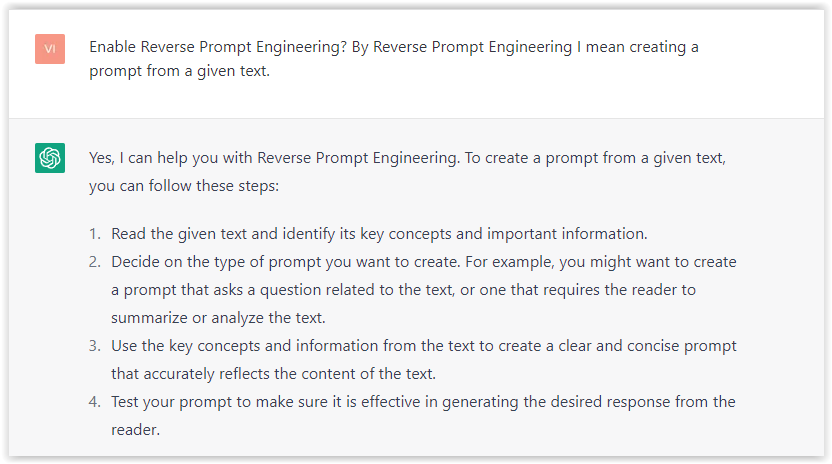 Screenshot from ChatGPT, March 2023
Screenshot from ChatGPT, March 2023You can test other GPT assistants available in the GPTs search engine if you want to use Google results.
Master Reverse Prompt Engineering
ChatGPT can be an excellent tool for reverse engineering prompts because it generates natural and engaging responses to any given input.
By analyzing the prompts generated by ChatGPT, it is possible to gain insight into the model’s underlying thought processes and decision-making strategies.
One key benefit of using ChatGPT to reverse engineer prompts is that the model is highly transparent in its decision-making.
This means that the reasoning and logic behind each response can be traced, making it easier to understand how the model arrives at its conclusions.
Once you’ve done this a few times for different types of content, you’ll gain insight into crafting more effective prompts.
Prepare Your ChatGPT For Generating Prompts
First, activate the reverse prompt engineering.
- Type the following prompt: “Enable Reverse Prompt Engineering? By Reverse Prompt Engineering I mean creating a prompt from a given text.”
 Screenshot from ChatGPT, March 2023
Screenshot from ChatGPT, March 2023ChatGPT is now ready to generate your prompt. You can test the product description in a new chatbot session and evaluate the generated prompt.
- Type: “Create a very technical reverse prompt engineering template for a product description about iPhone 11.”
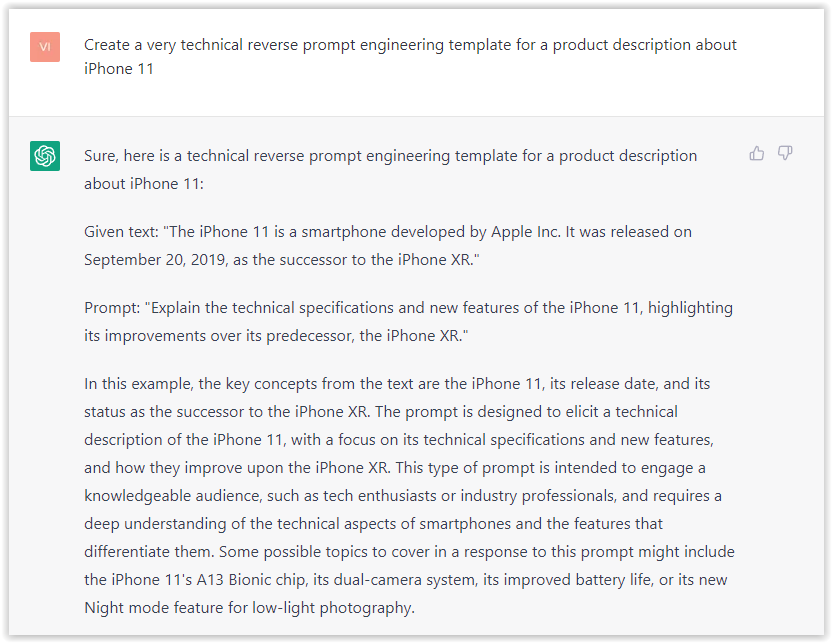 Screenshot from ChatGPT, March 2023
Screenshot from ChatGPT, March 2023The result is amazing. You can test with a full text that you want to reproduce. Here is an example of a prompt for selling a Kindle on Amazon.
- Type: “Reverse Prompt engineer the following {product), capture the writing style and the length of the text :
product =”
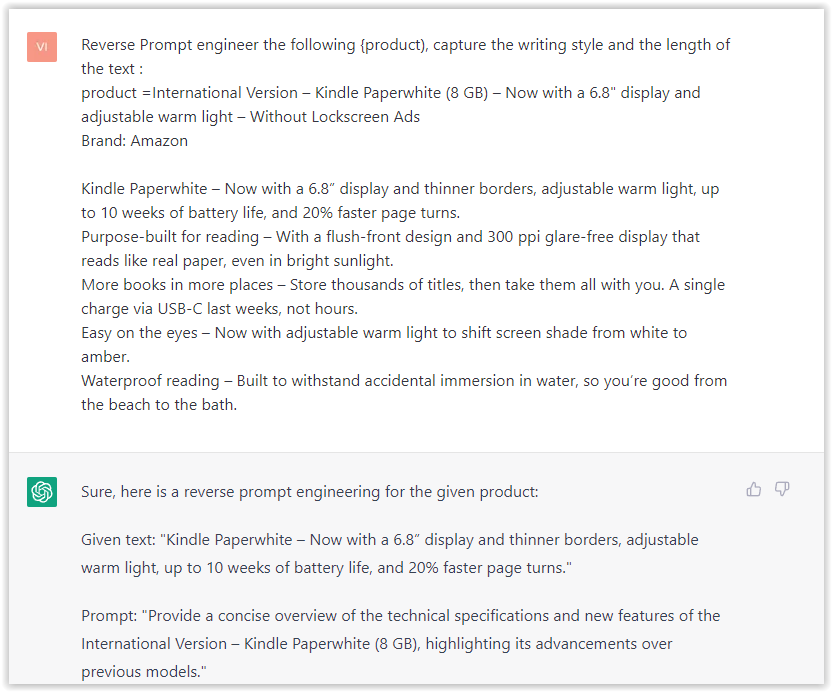 Screenshot from ChatGPT, March 2023
Screenshot from ChatGPT, March 2023I tested it on an SEJ blog post. Enjoy the analysis – it is excellent.
- Type: “Reverse Prompt engineer the following {text}, capture the tone and writing style of the {text} to include in the prompt :
text = all text coming from https://www.searchenginejournal.com/google-bard-training-data/478941/”
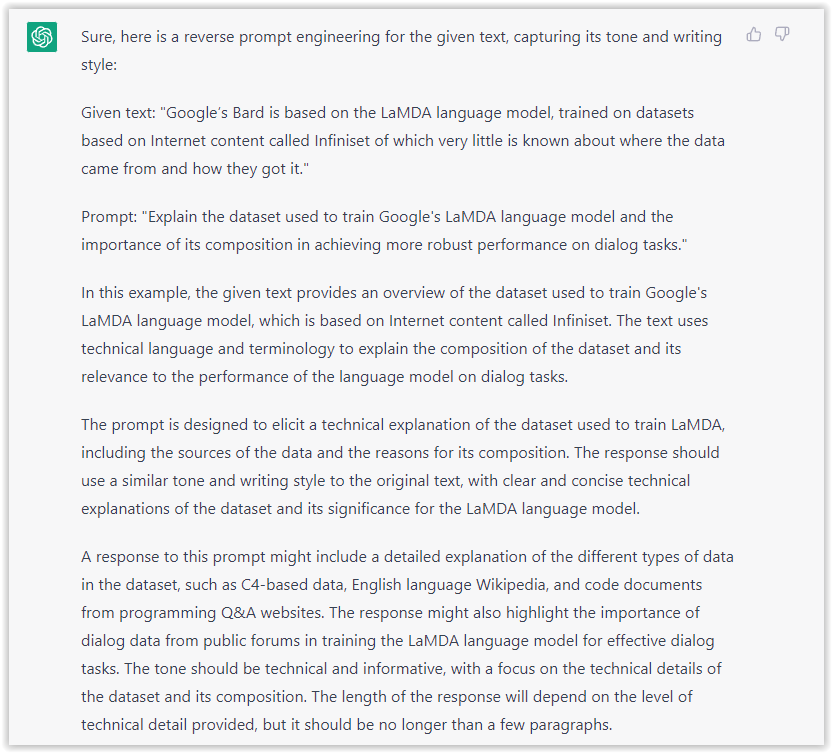 Screenshot from ChatGPT, March 2023
Screenshot from ChatGPT, March 2023But be careful not to use ChatGPT to generate your texts. It is just a personal assistant.
Go Deeper
Prompts and examples for SEO:
- Keyword research and content ideas prompt: “Provide a list of 20 long-tail keyword ideas related to ‘local SEO strategies’ along with brief content topic descriptions for each keyword.”
- Optimizing content for featured snippets prompt: “Write a 40-50 word paragraph optimized for the query ‘what is the featured snippet in Google search’ that could potentially earn the featured snippet.”
- Creating meta descriptions prompt: “Draft a compelling meta description for the following blog post title: ’10 Technical SEO Factors You Can’t Ignore in 2024′.”
Important Considerations:
- Always Fact-Check: While ChatGPT can be a helpful tool, it’s crucial to remember that it may generate inaccurate or fabricated information. Always verify any facts, statistics, or quotes generated by ChatGPT before incorporating them into your content.
- Maintain Control and Creativity: Use ChatGPT as a tool to assist your writing, not replace it. Don’t rely on it to do your thinking or create content from scratch. Your unique perspective and creativity are essential for producing high-quality, engaging content.
- Iteration is Key: Refine and revise the outputs generated by ChatGPT to ensure they align with your voice, style, and intended message.
Additional Prompts for Rewording and SEO:
– Rewrite this sentence to be more concise and impactful.
– Suggest alternative phrasing for this section to improve clarity.
– Identify opportunities to incorporate relevant internal and external links.
– Analyze the keyword density and suggest improvements for better SEO.
Remember, while ChatGPT can be a valuable tool, it’s essential to use it responsibly and maintain control over your content creation process.
Experiment And Refine Your Prompting Techniques
Writing effective prompts for ChatGPT is an essential skill for any SEO professional who wants to harness the power of AI-generated content.
Hopefully, the insights and examples shared in this article can inspire you and help guide you to crafting stronger prompts that yield high-quality content.
Remember to experiment with layering prompts, iterating on the output, and continually refining your prompting techniques.
This will help you stay ahead of the curve in the ever-changing world of SEO.
More resources:
Featured Image: Tapati Rinchumrus/Shutterstock
SEO
Measuring Content Impact Across The Customer Journey
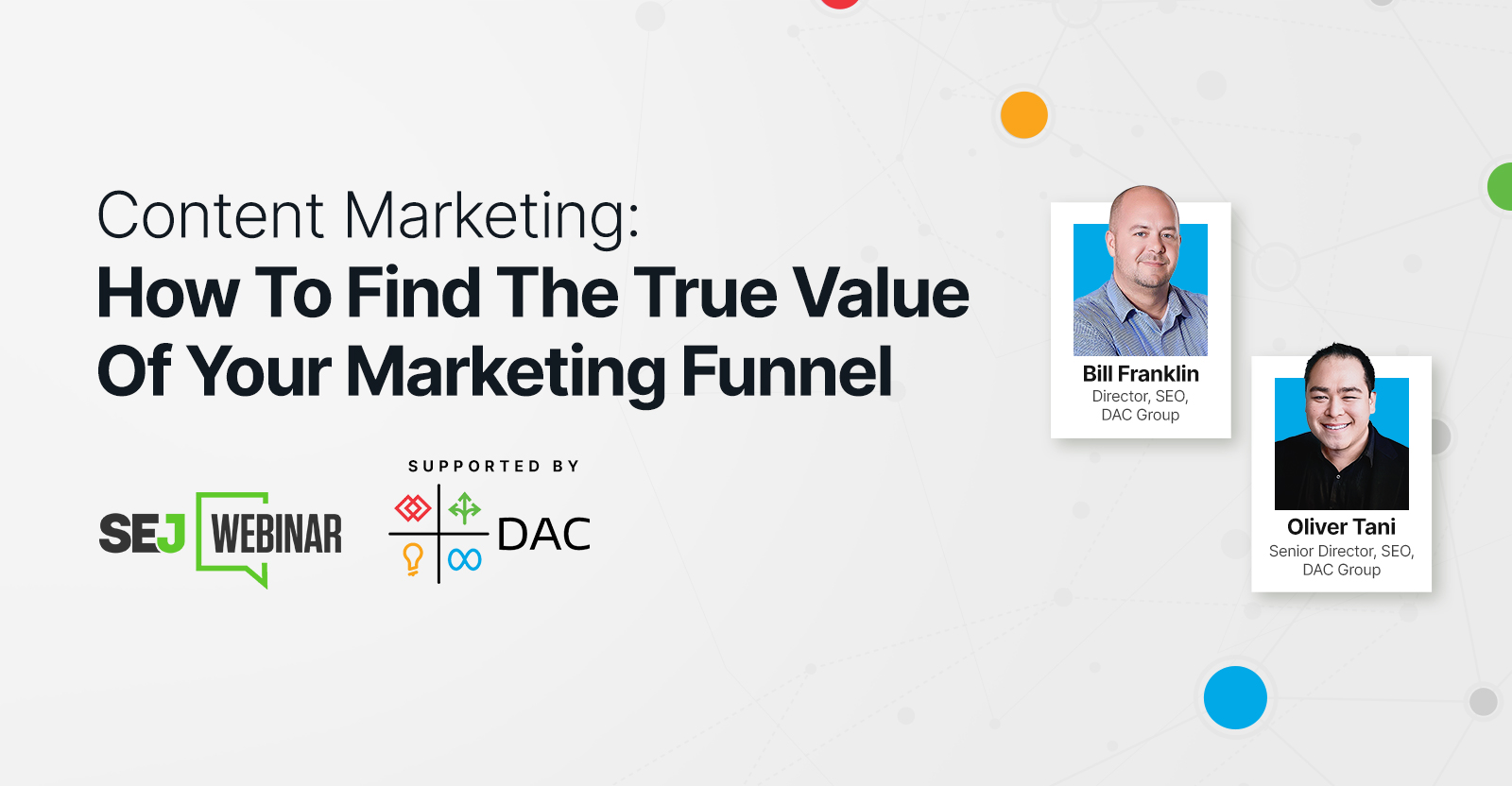
Understanding the impact of your content at every touchpoint of the customer journey is essential – but that’s easier said than done. From attracting potential leads to nurturing them into loyal customers, there are many touchpoints to look into.
So how do you identify and take advantage of these opportunities for growth?
Watch this on-demand webinar and learn a comprehensive approach for measuring the value of your content initiatives, so you can optimize resource allocation for maximum impact.
You’ll learn:
- Fresh methods for measuring your content’s impact.
- Fascinating insights using first-touch attribution, and how it differs from the usual last-touch perspective.
- Ways to persuade decision-makers to invest in more content by showcasing its value convincingly.
With Bill Franklin and Oliver Tani of DAC Group, we unravel the nuances of attribution modeling, emphasizing the significance of layering first-touch and last-touch attribution within your measurement strategy.
Check out these insights to help you craft compelling content tailored to each stage, using an approach rooted in first-hand experience to ensure your content resonates.
Whether you’re a seasoned marketer or new to content measurement, this webinar promises valuable insights and actionable tactics to elevate your SEO game and optimize your content initiatives for success.
View the slides below or check out the full webinar for all the details.
SEO
How to Find and Use Competitor Keywords
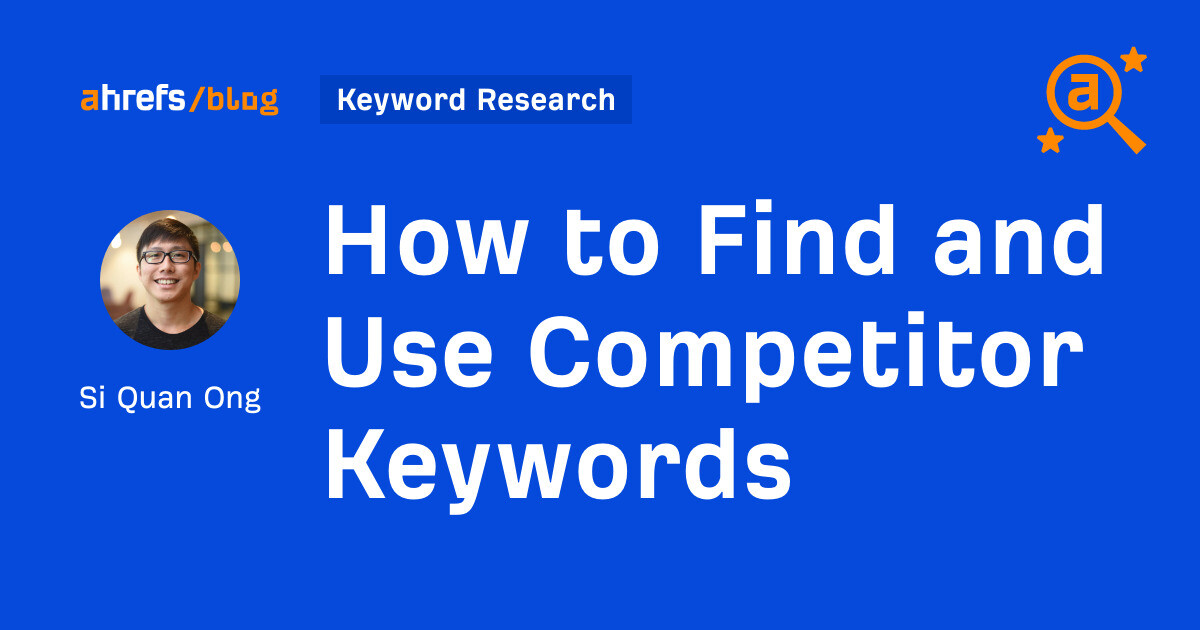
Competitor keywords are the keywords your rivals rank for in Google’s search results. They may rank organically or pay for Google Ads to rank in the paid results.
Knowing your competitors’ keywords is the easiest form of keyword research. If your competitors rank for or target particular keywords, it might be worth it for you to target them, too.
There is no way to see your competitors’ keywords without a tool like Ahrefs, which has a database of keywords and the sites that rank for them. As far as we know, Ahrefs has the biggest database of these keywords.
How to find all the keywords your competitor ranks for
- Go to Ahrefs’ Site Explorer
- Enter your competitor’s domain
- Go to the Organic keywords report
The report is sorted by traffic to show you the keywords sending your competitor the most visits. For example, Mailchimp gets most of its organic traffic from the keyword “mailchimp.”


Since you’re unlikely to rank for your competitor’s brand, you might want to exclude branded keywords from the report. You can do this by adding a Keyword > Doesn’t contain filter. In this example, we’ll filter out keywords containing “mailchimp” or any potential misspellings:
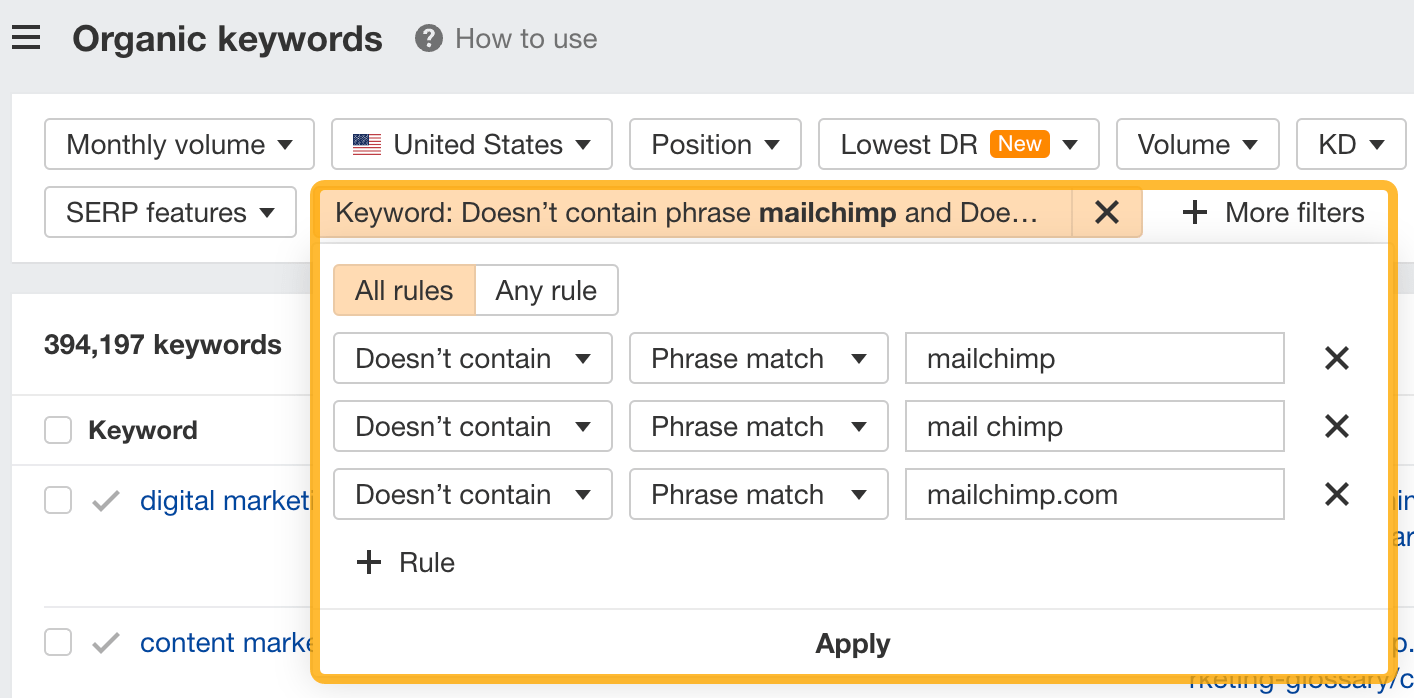

If you’re a new brand competing with one that’s established, you might also want to look for popular low-difficulty keywords. You can do this by setting the Volume filter to a minimum of 500 and the KD filter to a maximum of 10.
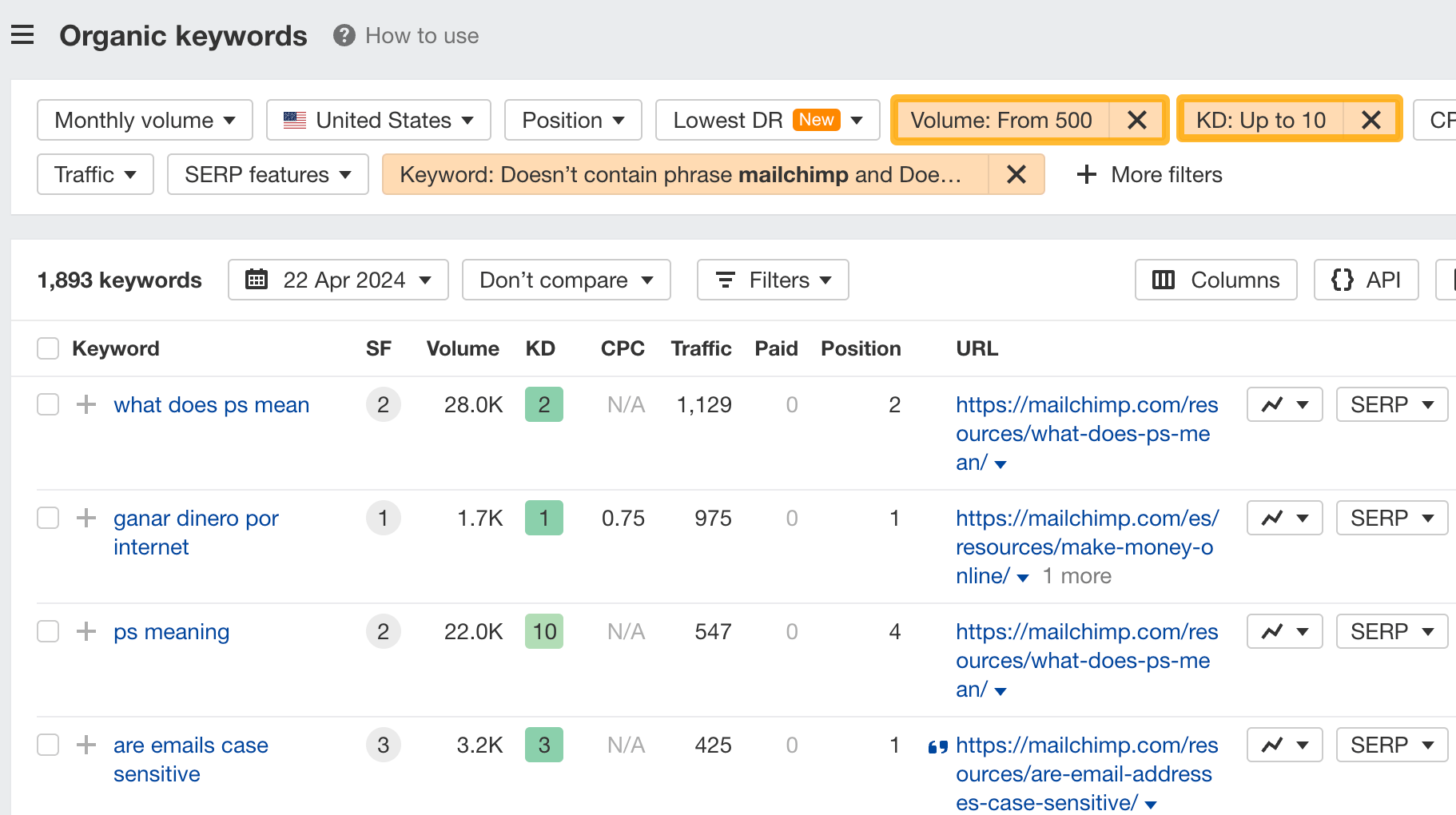

How to find keywords your competitor ranks for, but you don’t
- Go to Competitive Analysis
- Enter your domain in the This target doesn’t rank for section
- Enter your competitor’s domain in the But these competitors do section
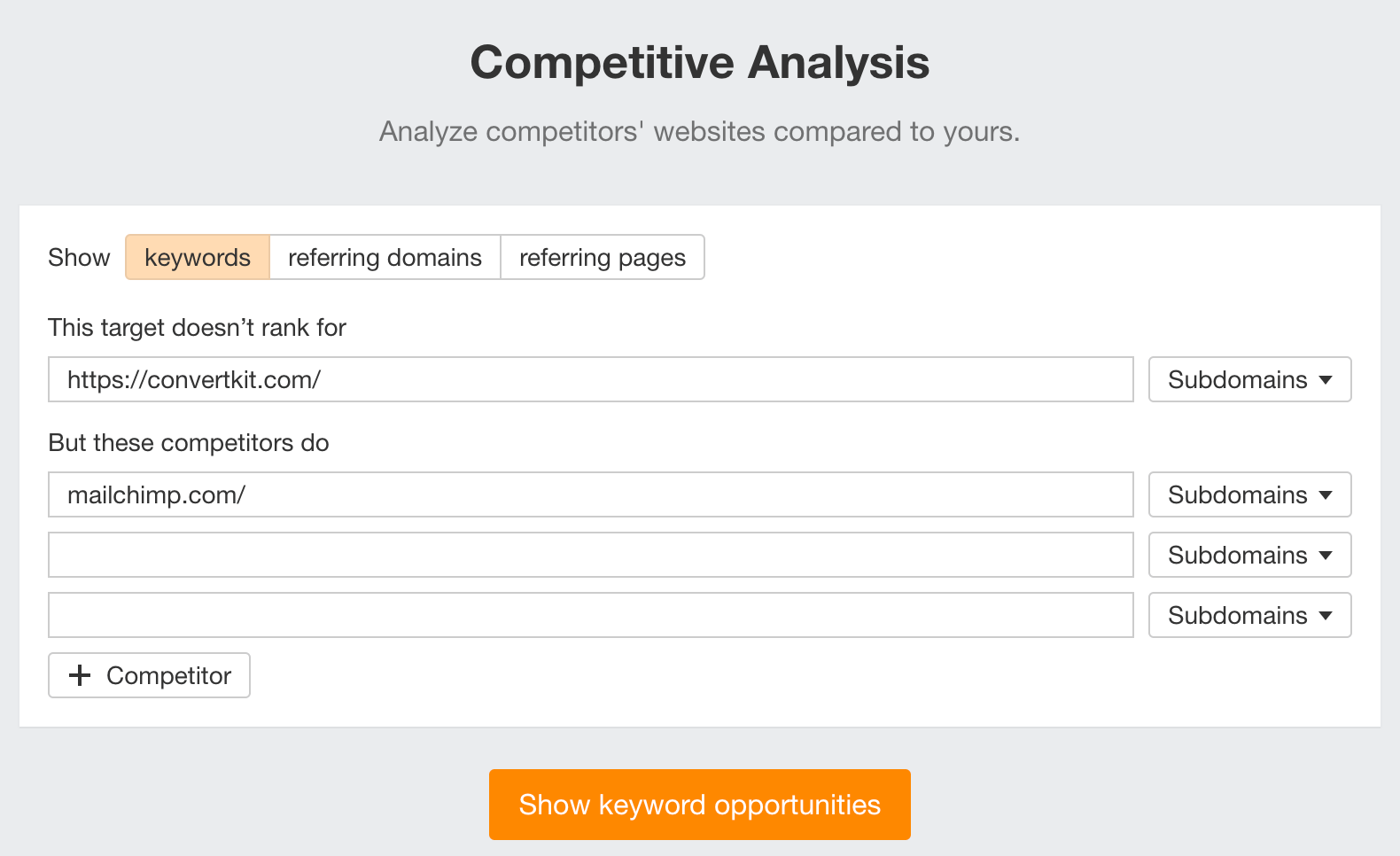

Hit “Show keyword opportunities,” and you’ll see all the keywords your competitor ranks for, but you don’t.
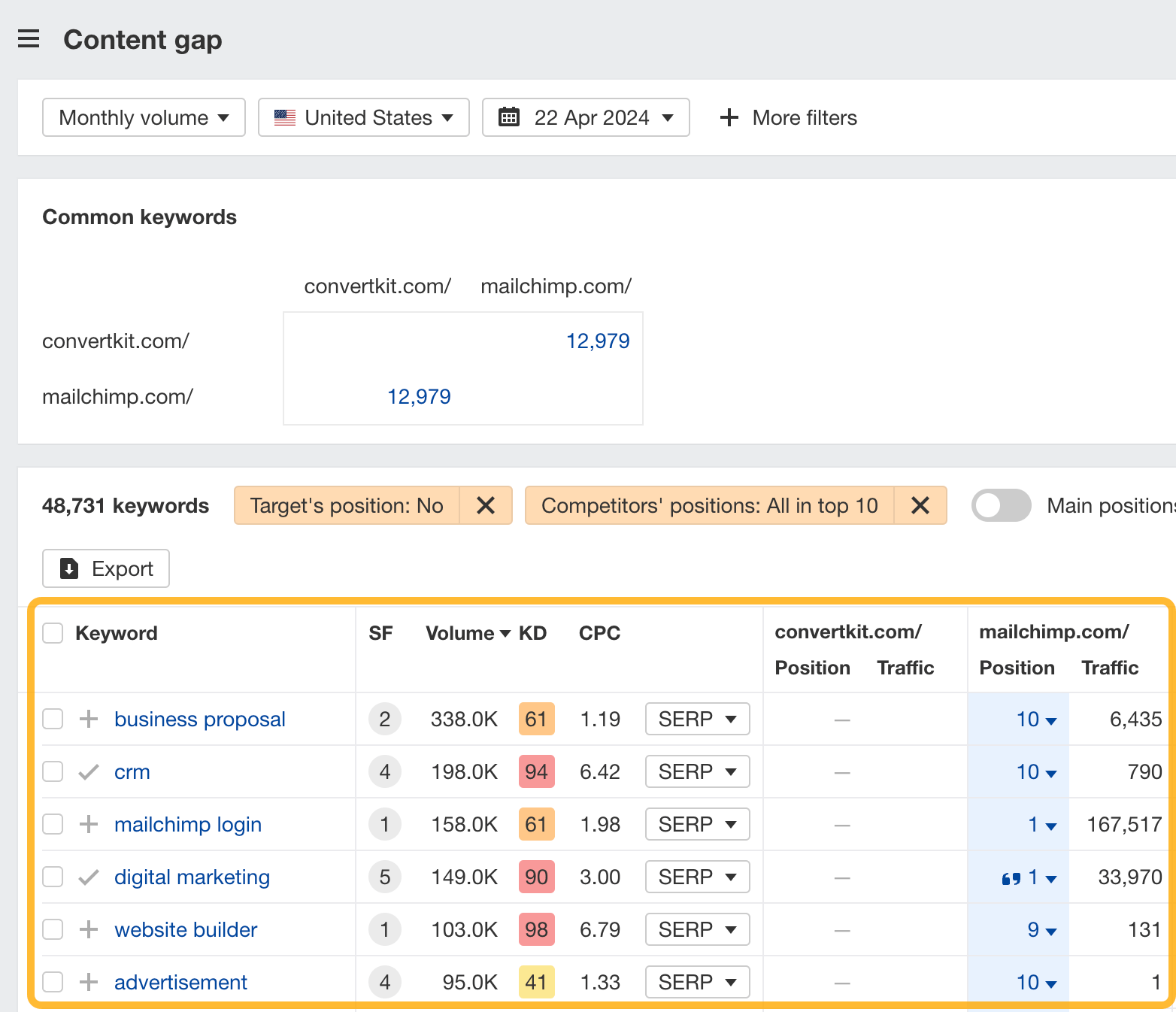

You can also add a Volume and KD filter to find popular, low-difficulty keywords in this report.
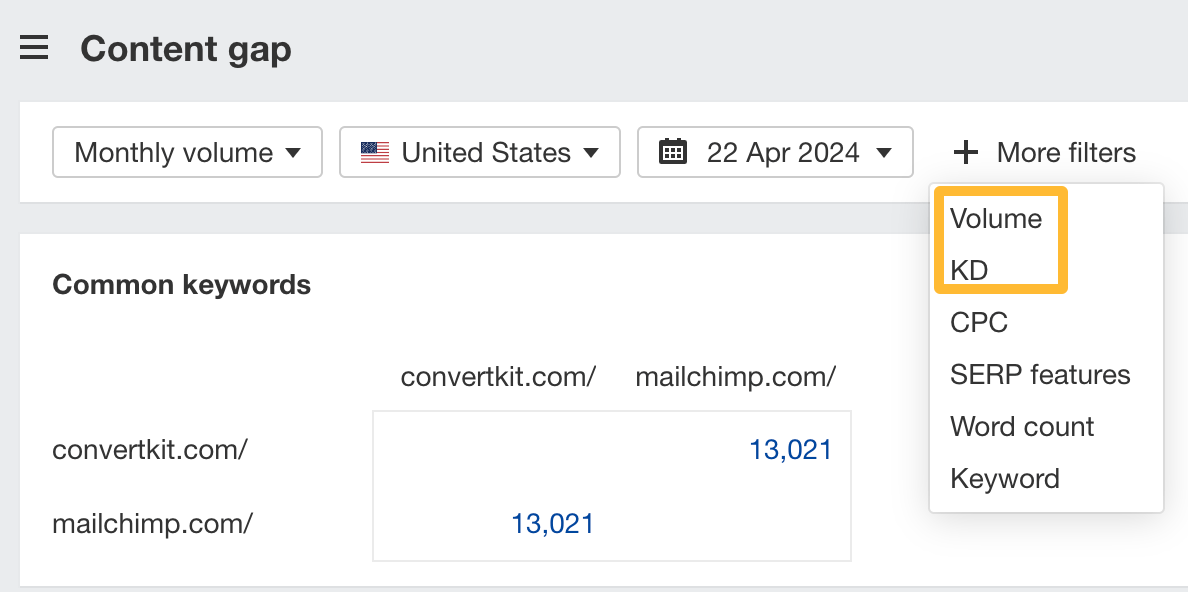

How to find keywords multiple competitors rank for, but you don’t
- Go to Competitive Analysis
- Enter your domain in the This target doesn’t rank for section
- Enter the domains of multiple competitors in the But these competitors do section
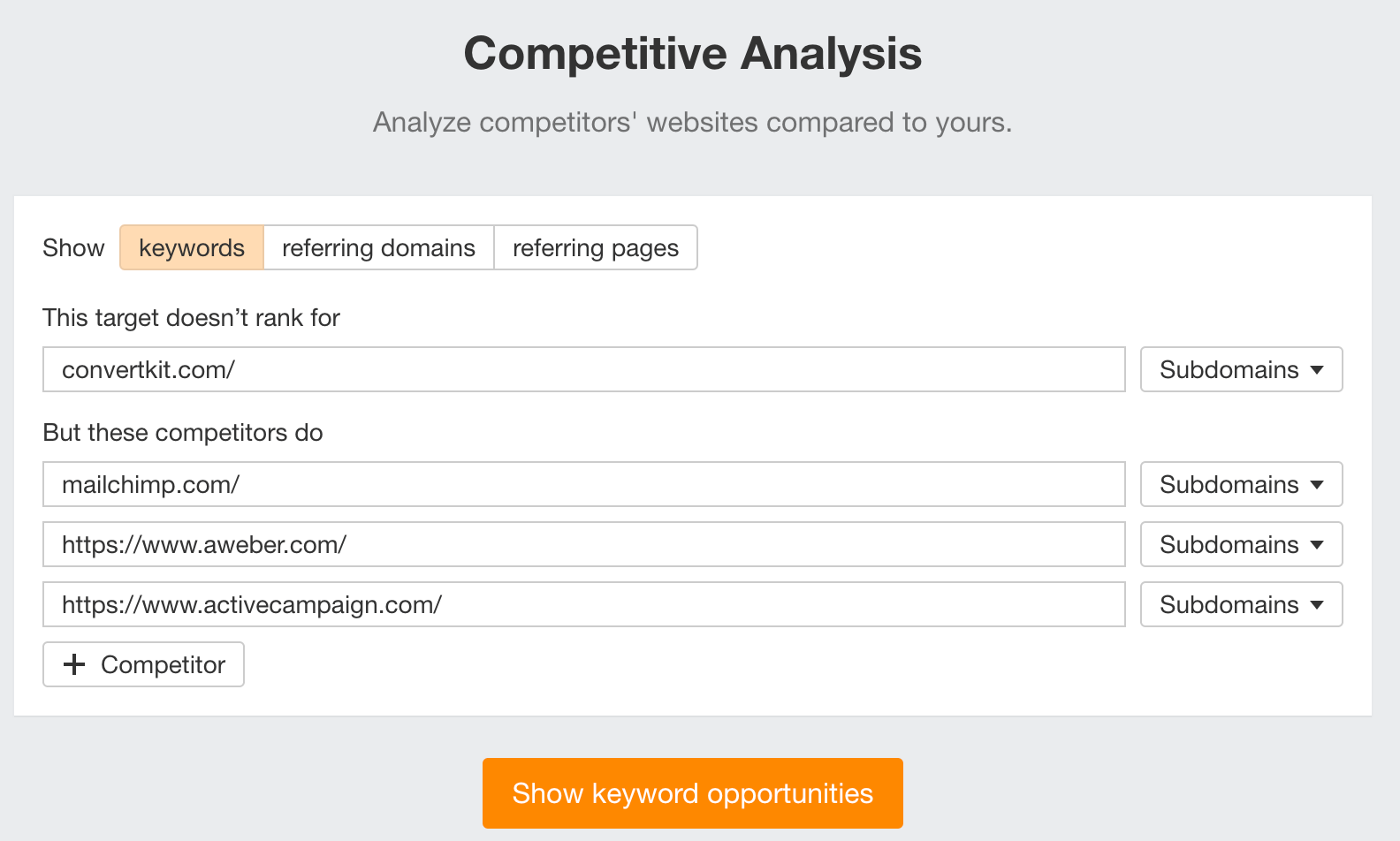

You’ll see all the keywords that at least one of these competitors ranks for, but you don’t.
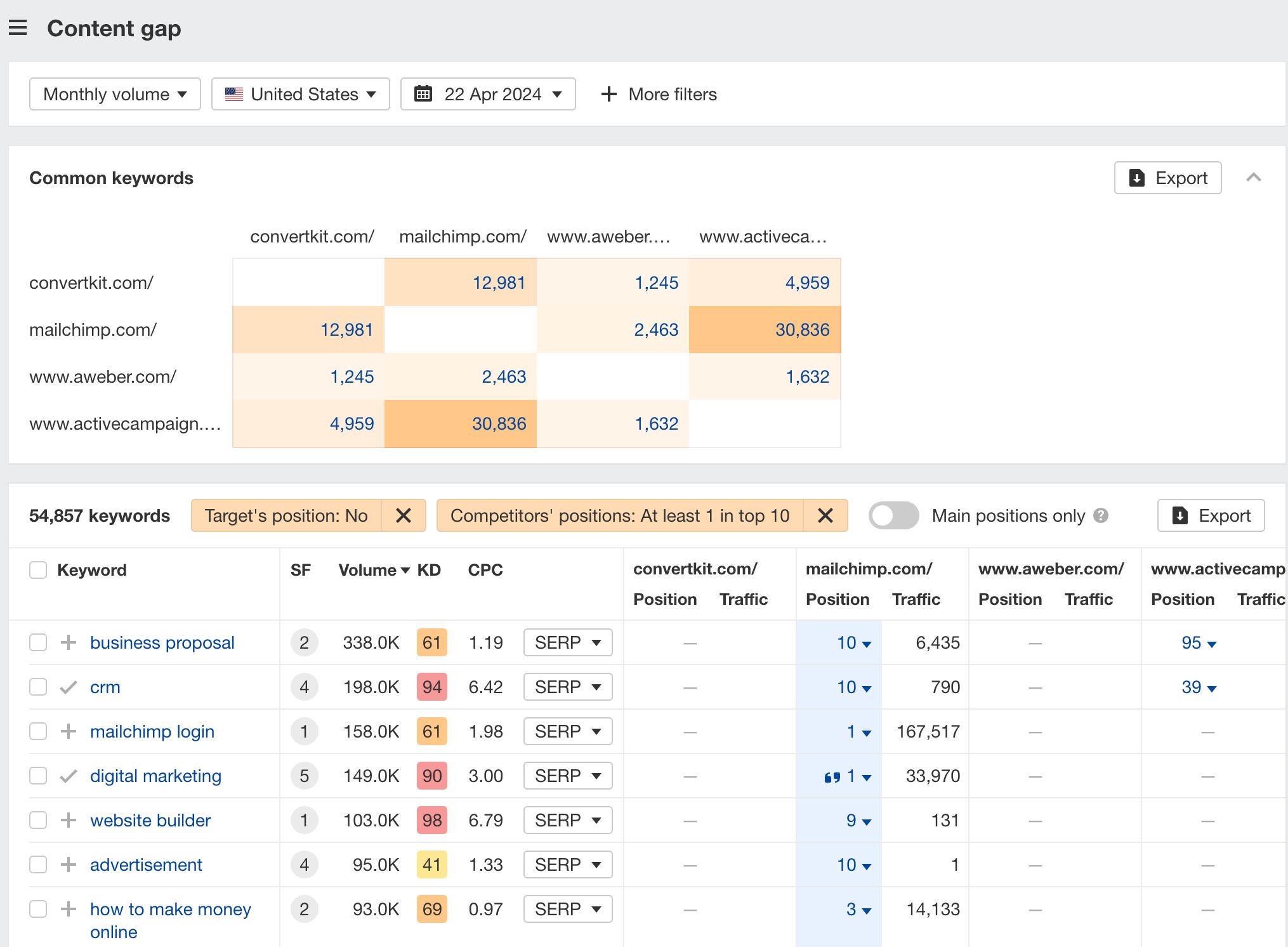

You can also narrow the list down to keywords that all competitors rank for. Click on the Competitors’ positions filter and choose All 3 competitors:
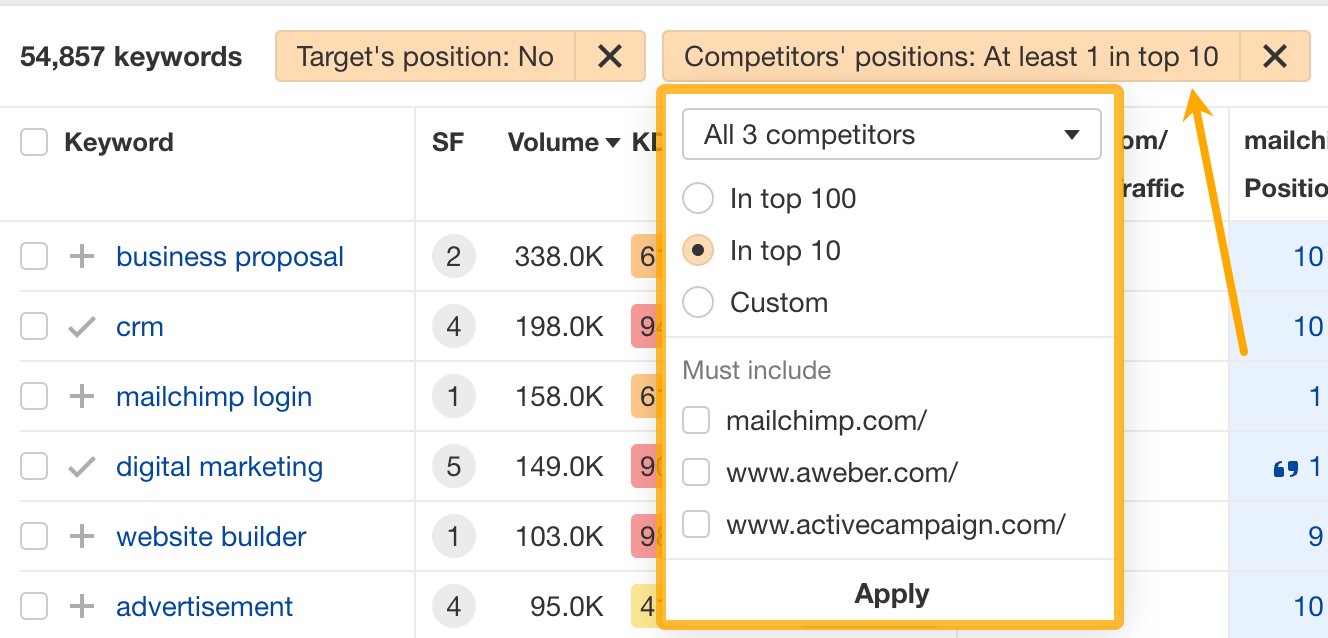

- Go to Ahrefs’ Site Explorer
- Enter your competitor’s domain
- Go to the Paid keywords report
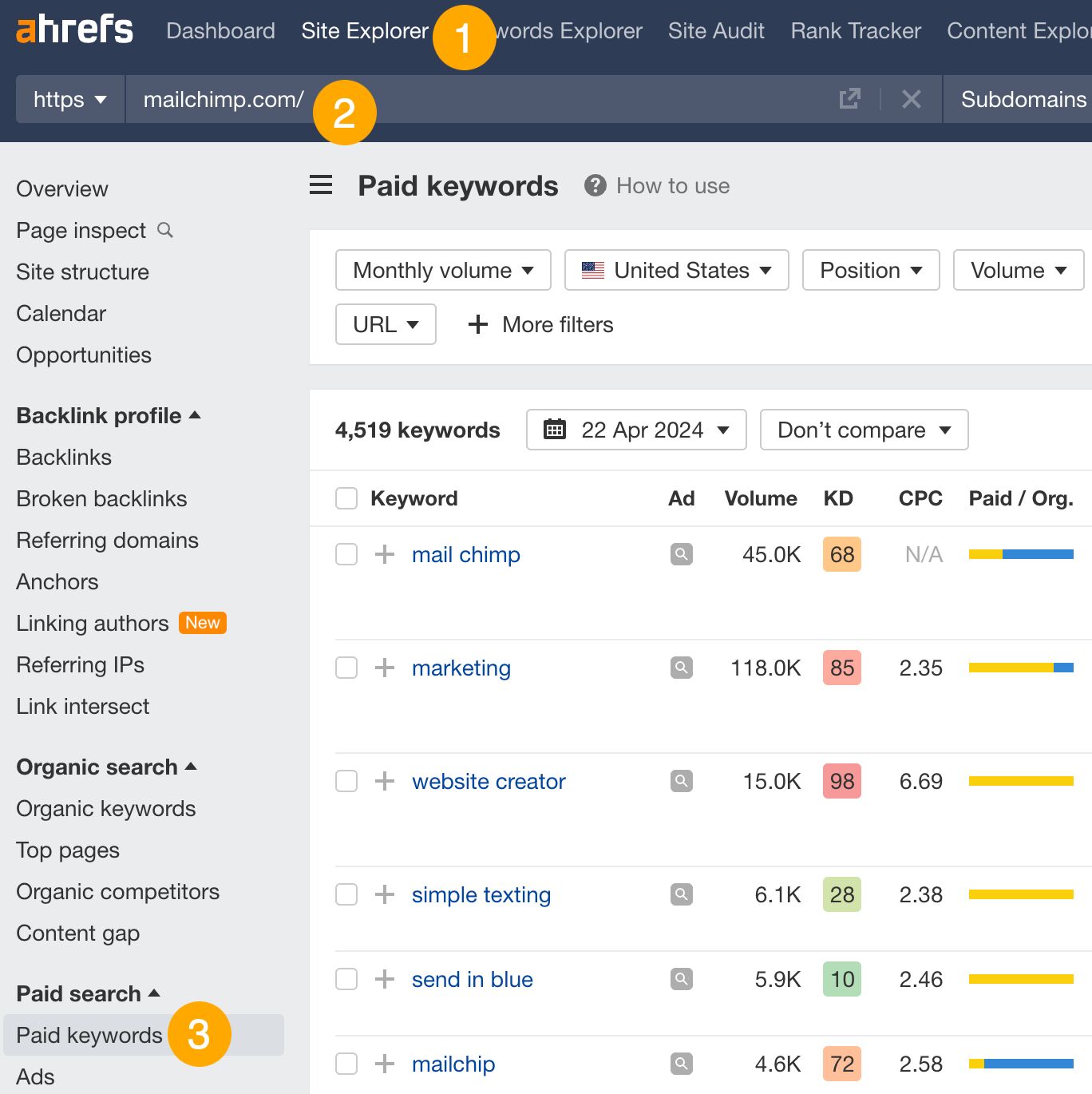

This report shows you the keywords your competitors are targeting via Google Ads.
Since your competitor is paying for traffic from these keywords, it may indicate that they’re profitable for them—and could be for you, too.
You know what keywords your competitors are ranking for or bidding on. But what do you do with them? There are basically three options.
1. Create pages to target these keywords
You can only rank for keywords if you have content about them. So, the most straightforward thing you can do for competitors’ keywords you want to rank for is to create pages to target them.
However, before you do this, it’s worth clustering your competitor’s keywords by Parent Topic. This will group keywords that mean the same or similar things so you can target them all with one page.
Here’s how to do that:
- Export your competitor’s keywords, either from the Organic Keywords or Content Gap report
- Paste them into Keywords Explorer
- Click the “Clusters by Parent Topic” tab
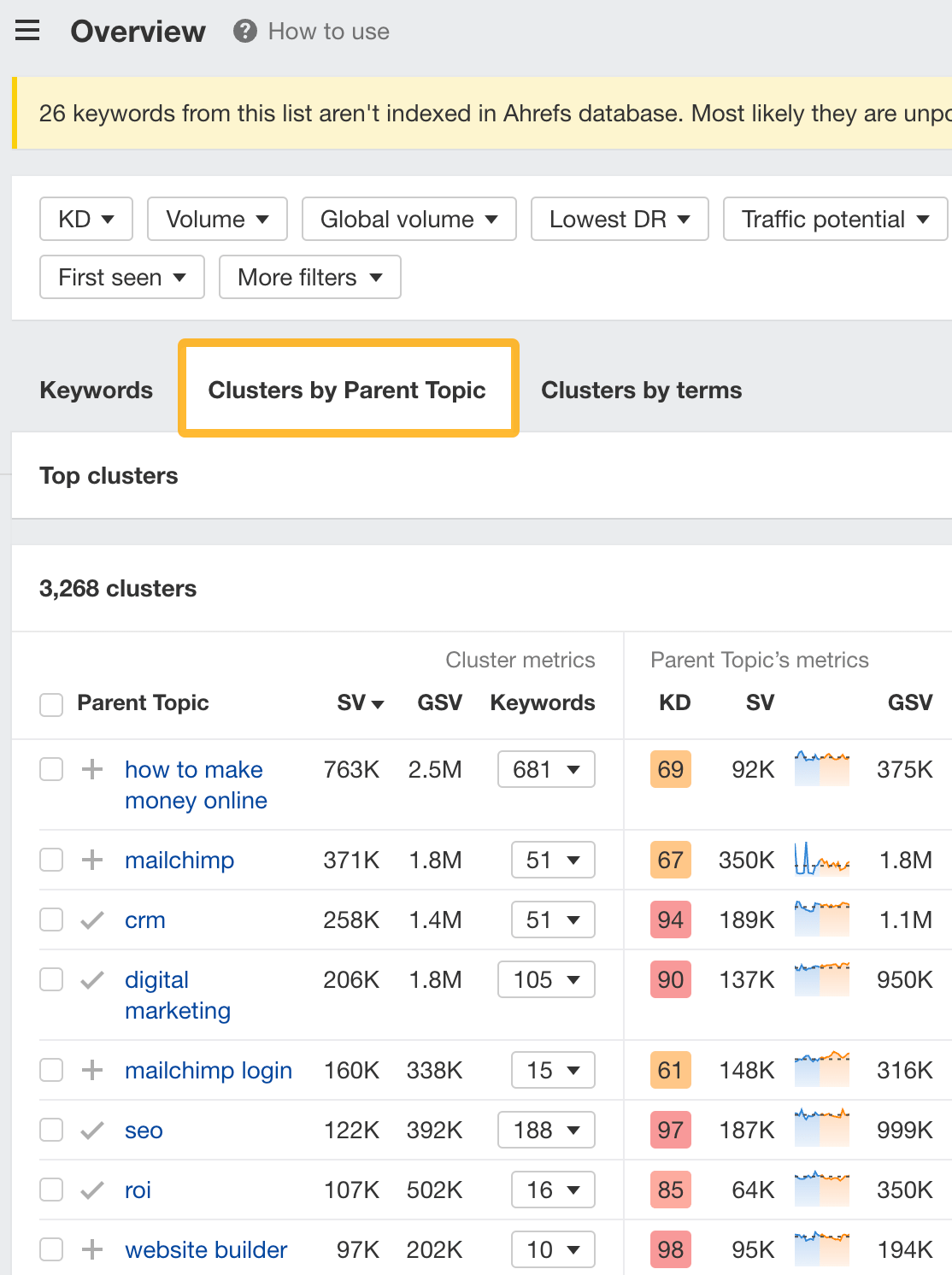

For example, MailChimp ranks for keywords like “what is digital marketing” and “digital marketing definition.” These and many others get clustered under the Parent Topic of “digital marketing” because people searching for them are all looking for the same thing: a definition of digital marketing. You only need to create one page to potentially rank for all these keywords.
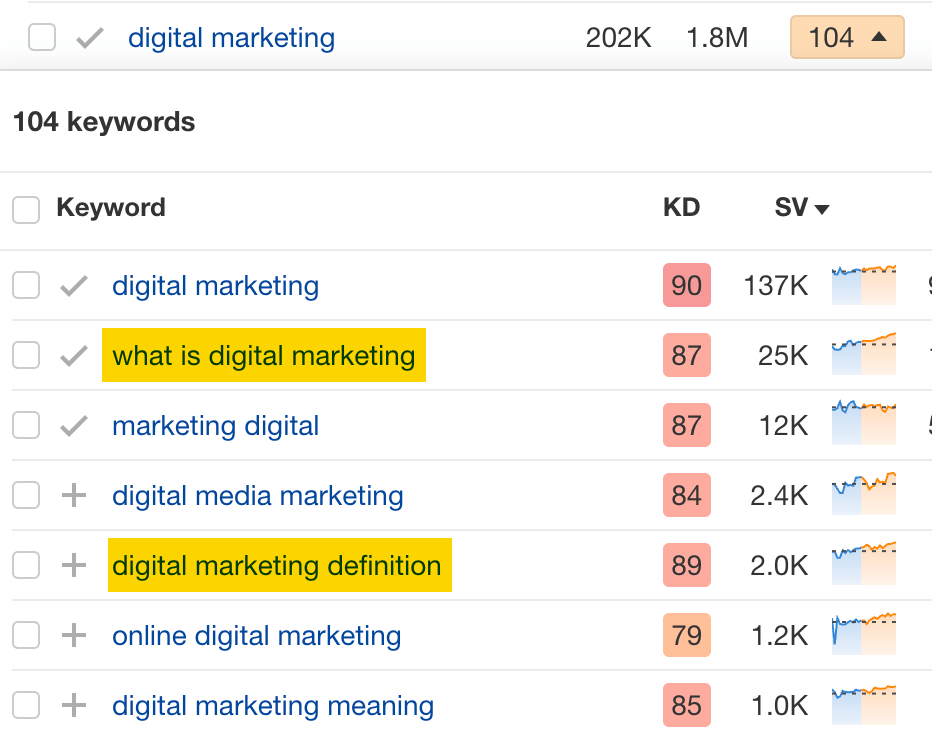

2. Optimize existing content by filling subtopics
You don’t always need to create new content to rank for competitors’ keywords. Sometimes, you can optimize the content you already have to rank for them.
How do you know which keywords you can do this for? Try this:
- Export your competitor’s keywords
- Paste them into Keywords Explorer
- Click the “Clusters by Parent Topic” tab
- Look for Parent Topics you already have content about
For example, if we analyze our competitor, we can see that seven keywords they rank for fall under the Parent Topic of “press release template.”


If we search our site, we see that we already have a page about this topic.


If we click the caret and check the keywords in the cluster, we see keywords like “press release example” and “press release format.”
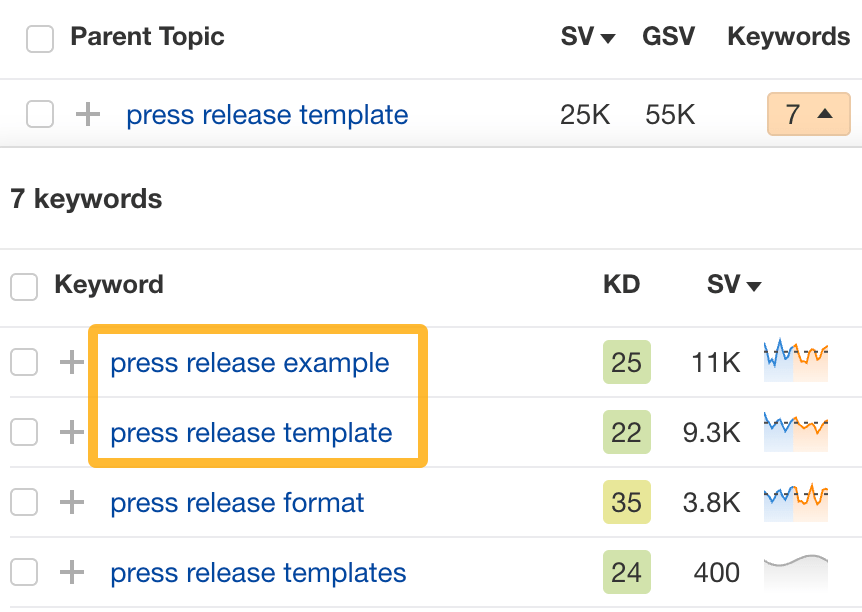

To rank for the keywords in the cluster, we can probably optimize the page we already have by adding sections about the subtopics of “press release examples” and “press release format.”
3. Target these keywords with Google Ads
Paid keywords are the simplest—look through the report and see if there are any relevant keywords you might want to target, too.
For example, Mailchimp is bidding for the keyword “how to create a newsletter.”


If you’re ConvertKit, you may also want to target this keyword since it’s relevant.
If you decide to target the same keyword via Google Ads, you can hover over the magnifying glass to see the ads your competitor is using.
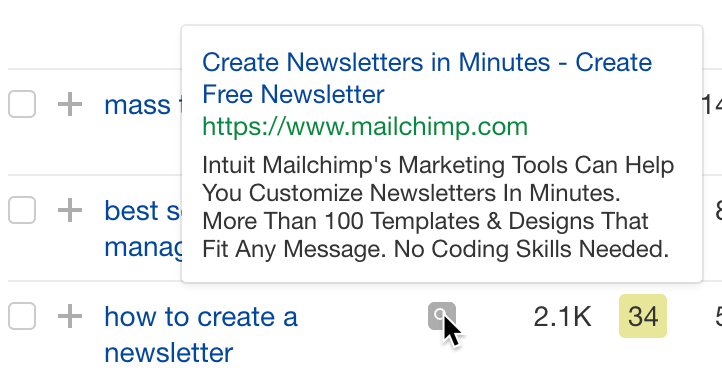

You can also see the landing page your competitor directs ad traffic to under the URL column.


Learn more
Check out more tutorials on how to do competitor keyword analysis:
-

 PPC5 days ago
PPC5 days ago19 Best SEO Tools in 2024 (For Every Use Case)
-
SEARCHENGINES7 days ago
Daily Search Forum Recap: April 17, 2024
-

 SEO7 days ago
SEO7 days agoAn In-Depth Guide And Best Practices For Mobile SEO
-
SEARCHENGINES6 days ago
Daily Search Forum Recap: April 18, 2024
-
SEARCHENGINES5 days ago
Daily Search Forum Recap: April 19, 2024
-

 MARKETING6 days ago
MARKETING6 days agoEcommerce evolution: Blurring the lines between B2B and B2C
-

 SEO6 days ago
SEO6 days ago2024 WordPress Vulnerability Report Shows Errors Sites Keep Making
-

 WORDPRESS5 days ago
WORDPRESS5 days agoHow to Make $5000 of Passive Income Every Month in WordPress
















You must be logged in to post a comment Login